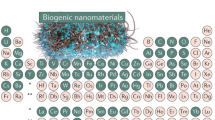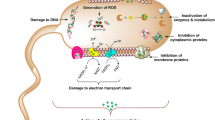Abstract
Microorganisms produce and secrete secondary metabolites to assist in their survival. We report that the gold resident bacterium Delftia acidovorans produces a secondary metabolite that protects from soluble gold through the generation of solid gold forms. This finding is the first demonstration that a secreted metabolite can protect against toxic gold and cause gold biomineralization.
This is a preview of subscription content, access via your institution
Access options
Subscribe to this journal
Receive 12 print issues and online access
$259.00 per year
only $21.58 per issue
Buy this article
- Purchase on Springer Link
- Instant access to full article PDF
Prices may be subject to local taxes which are calculated during checkout



Similar content being viewed by others
Accession codes
References
Vining, L.C. Annu. Rev. Microbiol. 44, 395–427 (1990).
Nies, D.H. Appl. Microbiol. Biotechnol. 51, 730–750 (1999).
Reith, F., Rogers, S.L., McPhail, D.C. & Webb, D. Science 313, 233–236 (2006).
Reith, F. et al. Geology 38, 843–846 (2010).
Reith, F. et al. Proc. Natl. Acad. Sci. USA 106, 17757–17762 (2009).
Reith, F., Lengke, M.F., Falconer, D., Craw, D. & Southam, G. ISME J. 1, 567–584 (2007).
Kashefi, K., Tor, J.M., Nevin, K.P. & Lovely, D.R. Appl. Environ. Microbiol. 67, 3275–3279 (2001).
Usher, A., McPhail, D.C. & Brugger, J. Geochim. Cosmochim. Acta 73, 3359–3380 (2009).
Hider, R.C. & Kong, X. Nat. Prod. Rep. 27, 637–657 (2010).
Kim, H.J. et al. Science 305, 1612–1615 (2004).
Chaturvedi, K.S. et al. Nat. Chem. Biol. 8, 731–736 (2012).
Stachelhaus, T., Mootz, H.D. & Marahiel, M.A. Chem. Biol. 6, 493–505 (1999).
Diels, L., Dong, Q., van der Lelie, D., Baeyens, W. & Mergeay, M. J. Ind. Microbiol. 14, 142–153 (1995).
Salem, I.B. et al. Ann. Microbiol. published online, 10.1007/s13213-012-0462-3 (2012).
Miller, M.C. et al. Microbiology 156, 2226–2238 (2010).
Hough, R.M. et al. Geology 36, 571–574 (2008).
Ojea-Jiménez, I., Romero, F.M., Bastús, N.G. & Puntes, V. J. Phys. Chem. C 114, 1800–1804 (2010).
Amin, S.A. et al. J. Am. Chem. Soc. 129, 478–479 (2007).
Pinel, N., Davidson, S.K. & Stahl, D.A. Int. J. Syst. Evol. Microbiol. 58, 2147–2157 (2008).
Weisburg, W.G., Barns, S.M., Pelletier, D.A. & Lane, D.J. J. Bacteriol. 173, 697–703 (1991).
Rausch, C., Weber, T., Kohlbacher, O., Wohlleben, W. & Huson, D.H. Nucleic Acids Res. 33, 5799–5808 (2005).
Ansari, M.Z., Yadav, G., Gokhale, R.S. & Mohanty, D. Nucleic Acids Res. 32, W405–W413 (2004).
Acknowledgements
This work was funded through Natural Sciences and Engineering Research Council (NSERC) of Canada Discovery grants (RGPIN 371576-2009; 101997-2006), an NSERC Strategic grant (STPGP385235-09) and a Canadian Foundation for Innovation grant (2010M00022). M.A.W. is funded through a Canadian Institutes of Health (CIHR) Doctoral Research Award. N.A.M. is funded by a CIHR New Investigator Award.
Author information
Authors and Affiliations
Contributions
C.W.J. isolated delftibactins, constructed the genetically modified strain, performed gold experiments and contributed to study design. M.A.W. isolated delftibactins, performed gold experiments and contributed to study design. X.L. performed structural analysis. A.I. performed structural and MS/MS analysis and isolated delftibactin B. J.S. obtained transmission electron microscopy (TEM) images. G.S. performed TEM image analysis. N.A.M. contributed to study design and wrote the manuscript. All authors discussed the results and commented on the manuscript.
Corresponding author
Ethics declarations
Competing interests
The authors declare no competing financial interests.
Supplementary information
Supplementary Text and Figures
Supplementary Results (PDF 881 kb)
Rights and permissions
About this article
Cite this article
Johnston, C., Wyatt, M., Li, X. et al. Gold biomineralization by a metallophore from a gold-associated microbe. Nat Chem Biol 9, 241–243 (2013). https://doi.org/10.1038/nchembio.1179
Received:
Accepted:
Published:
Issue Date:
DOI: https://doi.org/10.1038/nchembio.1179
This article is cited by
-
Potential of nano-phytoremediation of heavy metal contaminated soil: emphasizing the role of mycorrhizal fungi in the amelioration process
International Journal of Environmental Science and Technology (2024)
-
Bacterium Mediated Facile and Green Method for Optimized Biosynthesis of Gold Nanoparticles for Simple and Visual Detection of Two Metal Ions
Journal of Cluster Science (2021)
-
Emerging technologies for the recovery of rare earth elements (REEs) from the end-of-life electronic wastes: a review on progress, challenges, and perspectives
Environmental Science and Pollution Research (2020)



